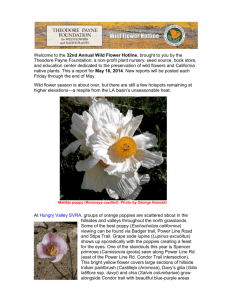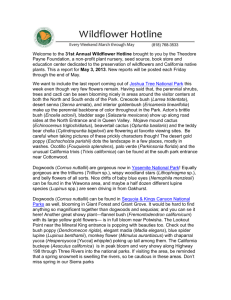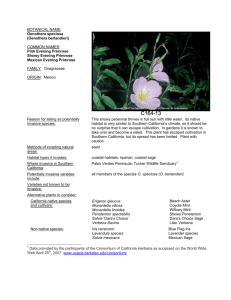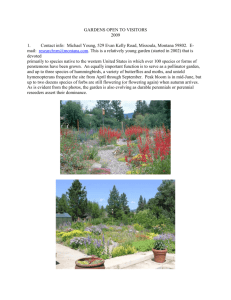doc May 24 - Theodore Payne Foundation
advertisement
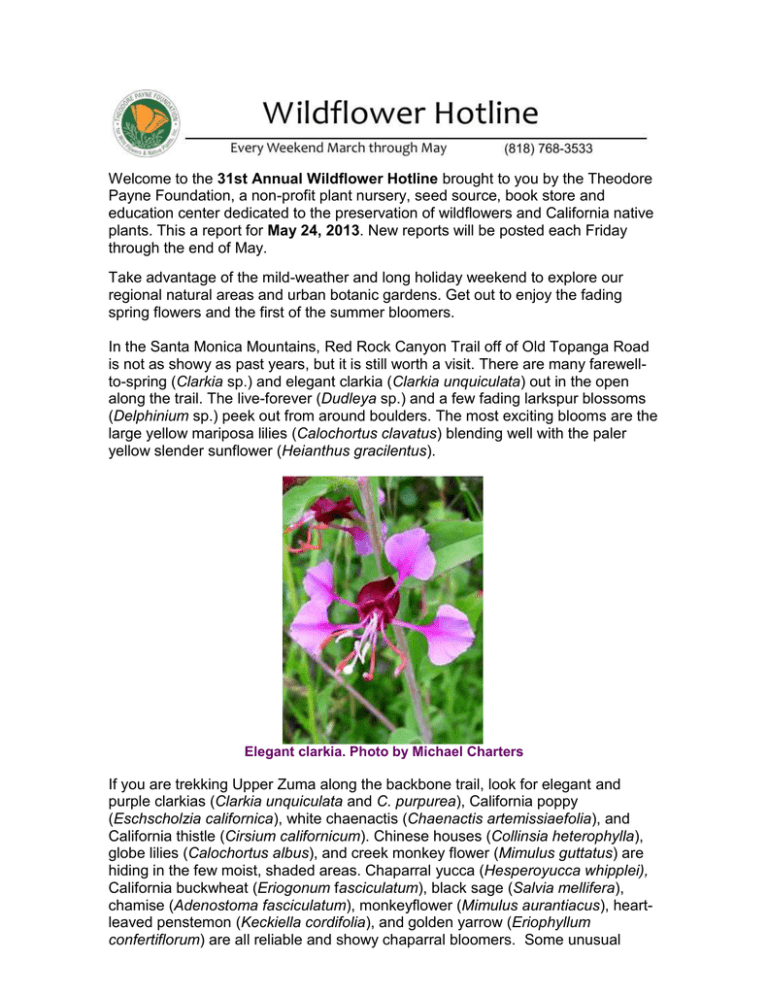
Welcome to the 31st Annual Wildflower Hotline brought to you by the Theodore Payne Foundation, a non-profit plant nursery, seed source, book store and education center dedicated to the preservation of wildflowers and California native plants. This a report for May 24, 2013. New reports will be posted each Friday through the end of May. Take advantage of the mild-weather and long holiday weekend to explore our regional natural areas and urban botanic gardens. Get out to enjoy the fading spring flowers and the first of the summer bloomers. In the Santa Monica Mountains, Red Rock Canyon Trail off of Old Topanga Road is not as showy as past years, but it is still worth a visit. There are many farewellto-spring (Clarkia sp.) and elegant clarkia (Clarkia unquiculata) out in the open along the trail. The live-forever (Dudleya sp.) and a few fading larkspur blossoms (Delphinium sp.) peek out from around boulders. The most exciting blooms are the large yellow mariposa lilies (Calochortus clavatus) blending well with the paler yellow slender sunflower (Heianthus gracilentus). Elegant clarkia. Photo by Michael Charters If you are trekking Upper Zuma along the backbone trail, look for elegant and purple clarkias (Clarkia unquiculata and C. purpurea), California poppy (Eschscholzia californica), white chaenactis (Chaenactis artemissiaefolia), and California thistle (Cirsium californicum). Chinese houses (Collinsia heterophylla), globe lilies (Calochortus albus), and creek monkey flower (Mimulus guttatus) are hiding in the few moist, shaded areas. Chaparral yucca (Hesperoyucca whipplei), California buckwheat (Eriogonum fasciculatum), black sage (Salvia mellifera), chamise (Adenostoma fasciculatum), monkeyflower (Mimulus aurantiacus), heartleaved penstemon (Keckiella cordifolia), and golden yarrow (Eriophyllum confertiflorum) are all reliable and showy chaparral bloomers. Some unusual cuties you may see include paintbrush (Castilleja sp.), red-skinned onion (Allium heamatochiton), canchalagua (Zeltnera venusta), checker bloom (Sidalcea malvaeflora), blue larkspur (Delphinium sp.) and cliff aster (Malacothrix saxatilis). Canchalagua (Zeltnera venusta). Photo by Michael Charters A segment of the Pacific Crest Trail in the San Gabriel Mountains between Little Rock Creek Road and Pacifico Mountain has a great diversity of flowering plants to explore. That’s the good news. The bad news is that the total number of these plants is low, so it may take some detective skills to find them. The most colorful trail species include pink splendid gilia, (Saltugilia splendens ssp. splendens), interior goldenbush (Ericameria linearifolia), the Mojave ceanothus (Ceanothus vestitus), flannel bush (Fremontodendron californicum), mountain currant (Ribes nevadense) and bush lupine (Lupinus excubitus ssp. austromontanus). Scattered about, you may spot Burlew’s wild onion (Allium burlewii), rock buckwheat (Eriogonum saxatile), Martin’s paintbrush (Castilleja applegatei var. martinii) and silver puffs (Uropappus lindleyi). A more intense search will reward you with canyon dudleya (Dudleya cymosa ssp. pumila) wallflower (Erysimum capitatum), scalebud (Anisocoma aculis) and rock cress (Boechera californica). This part of the trail is well maintained and rises from 5300 feet to 7100 feet in elevation. Along the Waterfall Trail at Placerita Canyon Natural Area, you will be able to enjoy Humboldt lilies (Lilium humboldtii) very soon. The buds are about ready to pop! In those shaded canyon areas, you can also spot wild California rose (Rosa californica), and boykinia (Boykinia sp.). On the sunnier trails, you can view our iconic chaparral species of flowering shrubs and seasonal wildflowers. Look for chaparral honeysuckle (Lonicera interrupta), and the red-orange heart-leaved penstemon (Keckiella cordifolia) arching their branches over other shrubs to reach the light. Golden yarrow (Eriophyllum confertiflorum), the fragrant vervain (Verbena sp.) and the interesting perezia (Acourtia microcephala) will definitely catch your eye. Yerba Santa (Eriodictyon californicum), holly-leaf cherry (Prunus ilicifolia), blue elderberry (Sambucus nigra), woolly blue curls (Trichostema lanatum), sticky-leaf monkey flower (Mimulus aurantiacus), and chaparral yucca (Hesperoyucca whipplei) are quite showy. The nice bloom of elegant clarkia (Clarkia unquiculata) and farewell-to-spring (Clarkia amoena), tell us that spring in the chaparral is coming to an end. Eaton Canyon in Pasadena has loads of buckwheat flowering especially in the lower wash. Hang out at the buckwheat for a time and you will be delighted with the number of butterflies that visit the tiny flowers of the buckwheat (Eriogonum fasciculatum). In the demonstration garden there is a spectacular stand of Matilija poppies (Romneya coulteri). White sage (Salvia apiana) and Cleveland sage (Salvia clevelandii) are in full bloom along with showy penstemon (Penstemon spectabilis) and California wishbone bush (Mirabilis californica). There are many other wonderful blooming plants in this foothill oasis. Take a leisurely outing to Descanso Gardens in La Cañada-Flintridge to enjoy both natives and Mediterranean relatives that are still showy throughout the garden. The Matilija poppies (Romneya coulteri) stand tall and showy with their large white flowers signaling you to come and take photos. Follow your nose to the mock orange (Philadelphus lewesii). This plant has the most amazing fragrance. Golden yarrow (Eriophyllum confertiflorum) forms bright golden-yellow beacons along the pathways; and along with the showy penstemon (Penstemon spectabilis), forms a spectacular blue and gold welcome banner for visitors. Visit Rancho Santa Ana Botanic Garden to see a native plant lover’s favorite woolly blue curls (Trichostema lanatum) “going gangbusters” up on the Mesa trails. In the desert garden, prickly pear cacti (Opuntia spp.), fairy dusters (Calliandra eriophylla), desert willow (Chilopsis linearis), and the ever majestic yuccas (Yucca schidigera and Y. whipplei) making a nice show. Look for seep monkeyflower (Mimulus guttatus) and Hooker’s evening primrose (Oenothera elata) around the ponds and sticky-leaf monkeyflower (Mimulus aurantiacus) and various penstemons (Penstemon spp.) along the sunnier pathways. The bush snapdragon (Keckiella antirrhinoides) and California buckeye (Aesculus californica) are scattered around. Over in the Channel Island section, dune primrose (Oenothera deltoides) and Island mallow (Malacothamnus clementinus) are very showy especially in early morning and late afternoon. Matilija poppies (Romneya coulteri) are blooming all over in the garden, but especially in the plant communities acreage. Every trail has a blooming treasure, so take a nice long walk and enjoy your visit. The late spring rain revitalized many annuals and perennials at Elizabeth Learning Center in Cudahy! Matilija poppies (Romenya coulteri), desert willow (Chilopsis linearis), Santa Rosa Island white-felted paintbrush (Castilleja hololeuca), red Island buckwheat (Eriogonum grande ssp. rubescens), Apache plume (Fallugia paradoxa), chaparral honeysuckle (Lonicera interrupta), San Diego sunflower (Hulsea californica), pink fairy duster (Calliandra eriophylla), Island bush poppy (Dendromecon harfordii), Santa Catalina Island Snapdragon (Gambelia speciosa), Farnsworth’s jewelflower (Streptanthus farnsworthianus ), blue palo verde, (Parkinsonia sp.), white sage (Salvia apiana) and clarkias (Clarkia spp.) are painting the Central Habitat Garden with a kaleidoscope of colors! Goldfields (Lasthenia sp.) have even had a mini-resurgence. The Desert Garden continues to have a nice diversity of blooms. Brown-eyed primrose (Chylismia claviformis), thistle sage (Salvia carduacea), Canterbury bells (Phacelia campanularia), desert blue bells (Phacelia parryi), California poppy (Eschscholzia californica), chia (Salvia columbariae), owls’ clover (Catilleja sp.), Spanish needle (Palafoxia linearis), forget-me-nots (Cryptantha sp.) and even Mojave lupine (Lupinus odoratus) all have new growth and blooms because of the late season rain. Bladderpod (Peritoma arborea), brittle bush (Encelia farinosa), apricot mallow (Sphaeralcea ambigua), chuparosa (Justicia californica) and skeleton milkweed (Asclepias subulata) continue to provide a bonanza of colors. Even the Ocotillo (Fouquieria splendens) has re-leafed! Desert Marigold (Baileya multiradiata) is starting to bloom in mass. In another week or two, its bright yellow will dominate.The Family Center/Clinic Garden still has lots of prickly poppy (Argemone munita), California buckwheat (Eriogonum fasciculatum) and Cleveland sage (Salvia clevelandii). At the Environmental Nature Center in Newport Beach, you can enjoy some of the showy Channel Island flora without the ocean crossing. The Island bush poppy (Dendromecon harfordii) is showier than its mainland cousin with larger flowers and foliage. Island snapdragon (Gambelia [Galvesia] speciosa) is a nice redflowered contrast to the bush poppy yellow. Two mallows, the San Clemente Island bush mallow, (Malacothamnus clementinus) and (Malva [Lavatera] assurgentiflora) have an array of lavender to purple color palette. The Catalina cherry, (Prunus ilicifolia ssp. lyonii), is a lovely evergreen flowering tree that is in flower as well. Speaking of trees, the California buckeye (Aesculus californica) still bears large flower spikes and entices you with the fragrance of grape soda and the flannel bushes (Fremontodendron californicum and F. mexicanum) still have a few golden blossoms on them. A few other favorites, Indian mallow (Abutilon palmeri) bladderpod (Peritoma [Isomeris] arborea), seaside daisy (Erigeron glaucus) and prickly pear cactus (Optuntia littoralis) have beautiful blossoms and worth the visit to Newport Beach to enjoy in this beautiful setting. The wildflower news is all good out of the Santa Ana Mountains, particularly on the trails along the Ortega Highway. The higher elevation chaparral on public trails is still beautiful and well worth the hike. There is a spectacular variety of wildflowers in the Blue Jay Camp ground, Chiquito Trail, the Los Pinos Peak Trail and the Bear Ridge Loop. The Cleveland National Forest’s very own monkeyflower (Mimulus clevlandii) stands out as a yellow beacon along the trails. There is still a ceanothus in bloom—the pretty blue wartleaf ceanothus (Ceanothus papillosus). Other iconic chaparral species that you will enjoy include chamise (Adenostoma fasciculatum), bush poppy (Dendromecon rigida), woolly blue curls (Trichostema sp.), sticky-leaf monkeyflower (Mimulus aurantiacus), showy penstemon (Penstemon spectabilis), paintbrush (Castilleja sp.), woolly Yerba Santa (Eriodictyon crassifolium) and golden yarrow (Eriophyllum confertiflorum) You should try to get out and hike this area this weekend. In the San Jacinto Mountains between Idyllwild and Pine Cove, the well maintained forest service roads will accommodate wandering botanists very nicely. The walk will take you through several habitats including pine forest, chaparral and grassy meadows. This area has been greatly thinned as part of a fuel reduction project. Botanically speaking the big winners are scarlet bugler (Penstemon centranthifolius) and Chaparral whitethorn (Ceanothus leucodermis) which our now thriving as a result of the open canopy. The heady fragrance of ceanothus wafts on the breeze. The showy pink bracted manzanita (Arctostaphylos pringlei ssp. drupacea) which is in its prime right now and the few-leaved checkerbloom (Sidalcea sparsiflora) is frequently encountered in the open grassy spaces along with the less conspicuous is Oak violet (Viola purpurea ssp. quercetorum). Quite amazing is the giant chain fern (Woodwardia fimbriata) with leaves up to 9 feet long. In much of Idyllwild one can see Indian milkweed (Asclepias eriocarpa), but at the lower elevations you may be lucky to spot its showier cousin the California milkweed (Asclepias californica). Other characteristic plants include bush poppy (Dendromecon rigida) and canyon sweet pea (Lathyrus vestitus var. vestitus). It is easy to miss the cryptic long-flowered thread plant (Nemacladus longiflorus var. longiflorus) because it blends with the background landscape so well. But look at the flower of this plant with a hand lens to see it’s tiny orchid like flower. It is a small splendor. The baby blue eyes (Nemophila menziesii var. menziesii) range in color from deep blue to white. The bright red snow plants (Sarcodes sanguinea) are still popping up everywhere in the pine needle litter. If you are traveling further afield this weekend, the dogwoods (Cornus nuttallii) are still in bloom at Sequoia and Kings Canyon National Parks. The best place to see them is in Giant Forest and Grant Grove; and the flannel bush (Fremontodendron californicum) with its large yellow-gold flowers—is still flowering near Potwisha. The California buckeye (Aesculus californica) is in peak bloom along Highway 198 through Three Rivers into the national parks; and lastly, the farewell-to-spring clarkias (Clarkia sp.) can be seen dotting the landscape here and there. The eastern side of the Sierra Nevada Mountains is also very nice. There are showy displays of desert sena (Senna armata) in full bloom along Highway 395 south of Ridgecrest. The road to Upper Gray’s Meadow west of Independence is spectacular with bush lupine (Lupinus excubitus). Pumice Valley including Panum Crater and the Convict Lake area has a blush of pink all over the landscape. Dwarf monkeyflower (Mimulus nanus ssp. mephiticus), desert peach (Prunus andersonii), desert phlox (Phlox stansburyi), wax currant (Ribes cereum). and mountain pride penstemon (Penstemon newberryi), are all “pretty in pink” right now. The trail around Convict Lake had tons of beautiful serviceberry (Amelanchier utahensis) in full bloom and in lower Lee Vining Canyon mountain mule ears (Wyethia mollis), Nuttall’s linanthus (Linanthus nuttallii) and wallflower (Erysimum capitatum) were in various stages of flowering. Continuing along Highway 395 south of Lee Vining, look for Sierra sulphur flower (Eriogonum umbellatum ssp. nevadense) and silvery lupine (Lupinus argenteus) lining the road. Desert peach, mountain pride penstemon & desert phlox – Eastern Sierra. Photos by Michael Charters Lastly, if you are traveling up the coast to Santa Barbara, be sure to visit the Santa Barbara Botanic Garden. A sure sign of Spring’s departure are the colorful displays of farewell-to-spring (Clarkia spp.) beginning to flower in the Meadow Section at the Santa Barbara Botanic Garden. Memorial Day weekend will provide an opportunity to see a number of other native California plants in full bloom, among them several massive displays of Matilija poppy (Romneya trichocalyx), accentuated by carpets of California poppy (Eschscholzia californica), jimson weed (Datura wrightii), and splashes of yellow evening primrose (Oenothera elata) and elegant tarplant (Madia elegans). Cultivars of coastal purple sage (Salvia leucophylla) are showing massive arrays of lavender to purple flowers. Several specimens of (Hesperoyucca whipplei) and California buckeye (Aesculus californica) are also in full bloom along the edge of the Meadow. The Desert Section adjacent to the Garden entrance is currently enhanced by a carpet of California evening primrose (Oenothera californica), best seen in the mid-morning. Other plants currently featuring abundant displays of color include fairy duster (Calliandra eriophylla), desert lavender (Hyptis emoryi), and Parry’s bear grass (Nolina parryi). Scattered throughout more shaded or cooler sites in the Garden one can find cardinal larkspur (Delphinium nudicaule), both color forms (yellow and red) of stream orchid (Epipactis gigantea), and Humboldt lily (Lilium humboldtii). These are especially prominent in the Garden’s orchid display next to the information kiosk. Stream orchids and California elk clover (Aralia californica) are also to be found along the edge of the trail through the Garden’s redwood section, where carpets of wild ginger (Asarum) and redwood sorrel (Oxalis oregona) are beginning to flower. That’s it for this week. Look for our last report on Friday, May 31. If you would like to be a wildflower reporter send your information about wildflower blooms and their location to by Wednesday of each week when blooms of note occur. NATIVE PLANT & WILDFLOWER EVENTS: Huntington Library When They Were Wild: Recapturing California’s Wildflower Heritage March 9 – June 10, 2013 Mary Lou and George Boone Gallery A collaborative project of The Huntington, Rancho Santa Ana Botanic Garden, and the Theodore Payne Foundation for Wildflowers and Native Plants. For more information, go to Huntington.org. Rancho Santa Ana Botanic Garden Garden Tours Weekends, March 23 through June 9, 1 p.m. Guided walking tours with Garden nature interpreters featuring beautiful California wildflowers and seasonal highlights. Free with standard Garden admission.

